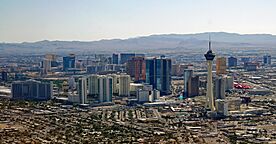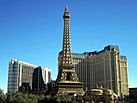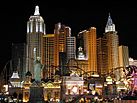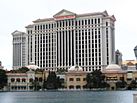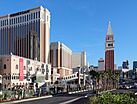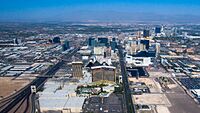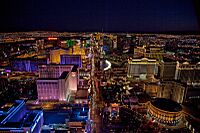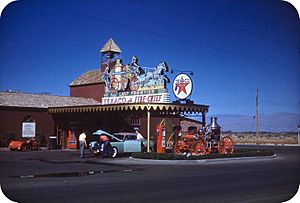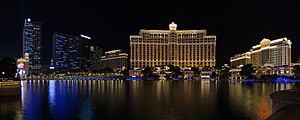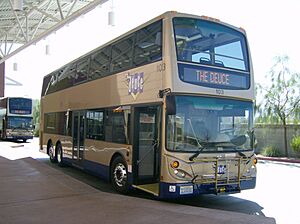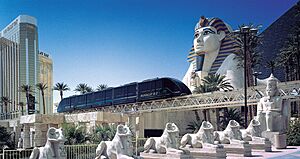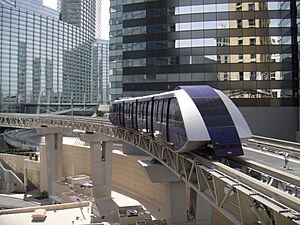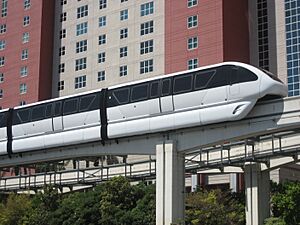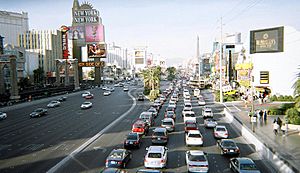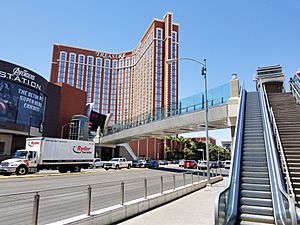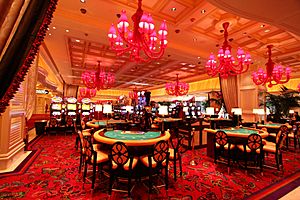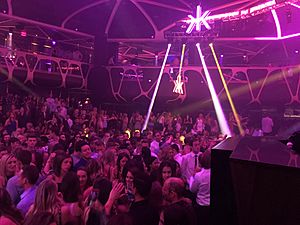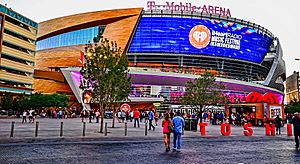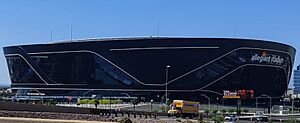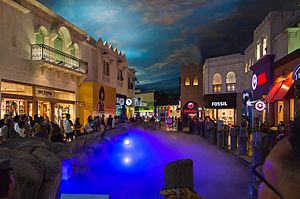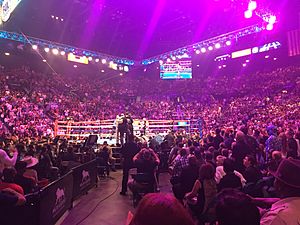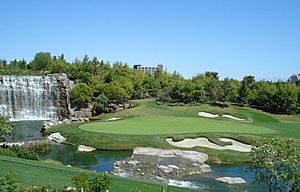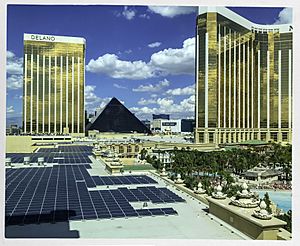Las Vegas Strip facts for kids
| The Strip Las Vegas Boulevard South |
|
|
Clockwise from top: Las Vegas Boulevard, MGM Grand Las Vegas, New York-New York, The Venetian Las Vegas, Caesars Palace, Horseshoe Las Vegas & Paris Las Vegas, Bellagio
|
|
| Length | 4.2 mi (6.8 km) |
|---|---|
| Coordinates | 36°07′11″N 115°10′21″W / 36.119684°N 115.172599°W |
| South end | Russell Road |
| North end | Sahara Avenue |
The Las Vegas Strip is a famous part of Las Vegas Boulevard in Clark County, Nevada. It's known for having many huge hotels and fun casinos. People often just call it The Strip. It's about 4.2 miles (6.8 km) long. Even though it's just outside the city of Las Vegas, in towns like Paradise and Winchester, everyone thinks of it as "Las Vegas."
Many of the world's biggest hotels and resorts are found here. The Strip's hotels, casinos, restaurants, and shows make it one of the most popular places to visit. It's a big reason why Las Vegas is so well-known. Most of the Strip is even a special road called an All-American Road.
Contents
What is the Las Vegas Strip?
The Strip is a specific section of Las Vegas Boulevard. It runs between Sahara Avenue and the famous "Welcome to Fabulous Las Vegas" sign. This sign was built in 1959. It's about 4.5 miles (7.2 km) from the city limits.
The Sahara hotel is usually seen as the northern end of the Strip. The Mandalay Bay hotel is the southernmost resort on the Strip. The "Welcome to Fabulous Las Vegas" sign marks the very southern end.
How the Las Vegas Strip Began
Early Days of Fun (1930s–1990s)
The first casino on this road was the Pair-o-Dice Club in 1931. Then, the first full hotel-casino, El Rancho Vegas, opened in 1941. It had 63 rooms and was a big hit! Soon after, the Hotel Last Frontier opened in 1942.
Other famous places like the Flamingo (1946) and Wilbur Clark's Desert Inn (1950) followed. Many of these early projects got money from a company in Galveston, Texas. The Strip got its name from a police officer and businessman named Guy McAfee. He named it after the "Sunset Strip" in Hollywood.
Why the Strip is Not in Las Vegas City
In 1950, the mayor of Las Vegas wanted the Strip to be part of the city. This would help the city get more tax money. But casino owners wanted to stay outside the city. So, two special towns were created: Paradise and Winchester. This way, the Strip stayed separate from the city of Las Vegas.
Big Hotels Arrive
Caesars Palace opened in 1966. In 1969, the International Hotel opened with 1,512 rooms. This started the age of "mega-resorts," which are super-large hotels. Today, the International is called Westgate Las Vegas.
The first MGM Grand Hotel and Casino opened in 1973 with over 2,000 rooms. In 1986, it was sold and renamed Bally's.
The Rise of Mega-Resorts
The opening of The Mirage in 1989 changed everything. It set a new standard for hotels in Las Vegas. Smaller hotels were replaced by even bigger, themed resorts. In the 1990s, more than 12 new hotels opened. These included places like the Luxor (shaped like a pyramid), Excalibur (like a castle), and Mandalay Bay.
The Bellagio, which opened in the 1990s, was one of the most expensive hotels ever built at the time. Also, the first Cirque du Soleil show, Mystère, started at Treasure Island in 1993. This made entertainment a huge part of the Strip's appeal.
The current MGM Grand opened in 1993. Besides hotels, the Strip also has attractions like M&M's World and the Fashion Show Mall.
The Strip Today (2000–Present)
Since 2000, the Strip has focused on luxury. Hotels like the Bellagio (1998), Venetian (1999), Wynn (2005), and Palazzo (2007) opened. Many older resorts also got big upgrades.
A huge project called CityCenter opened in 2009. It's a 66-acre (27 ha) area with hotels, shops, and homes.
In 2012, the High Roller Ferris wheel and The Linq Promenade opened. These added more fun things to do besides casinos. Other new places like The Cromwell Las Vegas and the SLS Las Vegas also changed the Strip. The Las Vegas Festival Grounds opened in 2015. In 2016, T-Mobile Arena and The Park opened. In 2017, a tragic event occurred near the Mandalay Bay hotel, which led to changes in security.
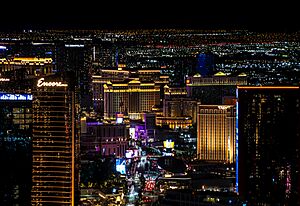
In 2021, the Pinball Hall of Fame moved to the south end of the Strip. Also, Resorts World Las Vegas opened in June 2021. The amazing Sphere opened in September 2023. The Fontainebleau Las Vegas also opened in December 2023. A new shopping center called BLVD opened in November 2024.
Future Plans for the Strip
The Tropicana hotel was taken down in October 2024. A new Bally's Las Vegas resort and a new baseball stadium for the Athletics team will be built there. They are set to open in 2028. The Mirage hotel also closed in July 2024. It will reopen as the Hard Rock Las Vegas in 2027.
Getting Around the Strip
Buses
RTC Transit has special double decker buses called The Deuce. They run along the Strip, stopping near almost every casino. You can ride them from the "Welcome to Fabulous Las Vegas" sign all the way to Downtown Las Vegas.
Trams
There are also free trams that connect some hotels on the west side of the Strip:
- The Mandalay Bay Tram links Mandalay Bay, Luxor, and Excalibur.
- The Aria Express connects Park MGM, Crystals (and Aria), and Bellagio.
- The Hard Rock-Treasure Island Tram runs between Treasure Island and Hard Rock Las Vegas (it's currently closed).
Monorail
The Las Vegas Monorail runs on the east side of the Strip. It's 3.9 miles (6.3 km) long and stops at several hotels. These include the MGM Grand and the Sahara.
The monorail started in 1995. In 2020, the Las Vegas Convention and Visitors Authority took it over.
Walking on the Strip
Thousands of people walk on the Strip every day. To make it safer and easier, many special bridges for walkers were built in the 1990s. These bridges help people cross busy roads without stopping traffic. Some bridges even match the themes of nearby hotels!
Some of these footbridges include:
- Veer Towers: Connects Veer Towers, Waldorf Astoria, and Crystals Shopping Center.
- Park MGM and T-Mobile Arena Park: Connects MGM and Showcase Mall.
- Planet Hollywood: Connects Planet Hollywood, CityCenter, Crystals Shopping Center, and The Cosmopolitan.
- Spring Mountain Road and Las Vegas Blvd. Corner: Connects Treasure Island, the Wynn, Fashion Show Mall, and The Venetian.
- Flamingo Road and Las Vegas Blvd. Corner: Connects Bally's, Flamingo, Bellagio, and Caesars Palace.
- Las Vegas Blvd and Tropicana Ave Corner: Connects the MGM Grand, New York-New York, Excalibur, and Tropicana.
Taxis
Taxis are easy to find at hotels, shops, and attractions. In recent years, more people have been taking taxis. This is partly because there are fewer rideshare drivers.
Fun Things to Do on the Strip
Gaming Fun
Most visitors to Las Vegas try gambling. They spend about 2.7 hours gambling on average. The average budget for gambling is around $591. Most of this gambling happens on the Strip.
Casinos offer many different games. Some popular ones are Blackjack, Craps, and Roulette. Games like Baccarat and three-card poker have also become very popular. Casinos are also making their sports betting areas better. They have big screens and comfy seats. Some even have self-service kiosks for betting.
Amazing Entertainment
The Las Vegas Strip is famous for its shows, nightclubs, and lounges. Many of these are inside the hotel casinos. Some free attractions you can see from the Strip include the dancing water fountains at Bellagio.
There are also several amazing Cirque du Soleil shows. These include Kà at the MGM Grand and O at Bellagio. Many famous artists have performed in Las Vegas. These include Elvis Presley, Frank Sinatra, Celine Dion, and Lady Gaga. In 2019, about half of all visitors went to a show.
Places for Shows and Events
The Strip has many places for entertainment. Most hotels have a showroom or nightclub. Some even have huge arenas.
- The Colosseum at Caesars Palace
- Dolby Live
- Las Vegas Festival Grounds
- Sphere
- T-Mobile Arena
- Allegiant Stadium
Yummy Food
The Strip has many restaurants, from casual to fancy. Many famous chefs have opened restaurants here. These include Wolfgang Puck, Gordon Ramsay, and Joël Robuchon.
Shopping Fun
The Strip is a great place to shop!
- Bonanza Gift Shop is called the "World's Largest Gift Shop."
- Fashion Show Mall is a big mall near Treasure Island.
- Grand Canal Shoppes is a fancy mall at Venetian. It even has canals and gondolas!
- The Linq Promenade is an outdoor area with shops and restaurants. It leads to the High Roller.
- Miracle Mile Shops is part of the Planet Hollywood resort.
- The Forum Shops at Caesars is a luxury mall at Caesars Palace.
- The Shops at Crystals is a high-fashion mall at CityCenter.
- Showcase Mall is next to the MGM Grand. It has a giant Coca-Cola bottle!
Live Sports
You can watch professional sports on or near the Strip:
- Football: Las Vegas Raiders at Allegiant Stadium.
- Hockey: Vegas Golden Knights at T-Mobile Arena.
- Basketball: Las Vegas Aces at the Michelob Ultra Arena.
- The Strip also hosts the Las Vegas Grand Prix for Formula One racing.
Golf Courses
In the past, many hotels had golf courses. But as land became more valuable, most were removed. The Wynn Golf Club closed for a while but reopened in 2019. The Bali Hai Golf Club opened south of Mandalay Bay in 2000. In 2016, a TopGolf opened near the Strip.
Amusement Parks and Rides
Adventuredome is an indoor amusement park at Circus Circus. It has roller coasters, mini-golf, and arcade games.
The Stratosphere tower has several thrilling rides:
- Big Shot
- X-Scream
- SkyJump Las Vegas
Other fun rides on the Strip include:
- Big Apple Coaster at New York-New York.
- High Roller, a giant Ferris wheel.
- Fly Linq, a zipline.
Keeping the Strip Green
Even with all its bright lights, many hotels on the Strip are working to be eco-friendly.
- Saving Water: They reuse water, use less water for landscaping, and have water-saving toilets and showers.
- Recycling: Hotels on the Strip recycle about 40% of their waste.
- Food Waste: Leftover food is composted or sent to farms. Unused food is given to food banks.
- Energy Saving: Hotels use LED lights and updated appliances to save energy.
Many hotels also use renewable energy. The Mandalay Bay has a huge solar panel system on its roof. It's one of the biggest in the United States! This system can power 25% of the Mandalay Bay. Many buildings on the Strip are also LEED-certified, meaning they are built to be very energy efficient.
Famous Places on the Strip
Current Landmarks
| North towards Fremont Street
↑ |
||
| Strat | Las Vegas Boulevard | |
| Aztec Inn | ||
| Ahern, Allure, Bonanza Gift Shop | ||
| Sahara Avenue | Sahara Avenue | |
| Festival Grounds | Sahara | |
| Hilton Grand Vacations | LVXP Las Vegas (planned) | |
| Sky | Fontainebleau, Turnberry Place, Westgate | |
| Circus Circus | ||
| Slots-A-Fun | Peppermill, Convention Center | |
| Resorts World | Guardian Angel Cathedral | |
| Desert Inn Road | Desert Inn Road | |
| Trump | Encore | |
| Fashion Show Mall | Wynn | |
| Spring Mountain Road | Sands Avenue | |
| Treasure Island | Palazzo, Venetian Expo | |
| Venetian, Sphere | ||
| Hard Rock (construction) | Casino Royale | |
| Harrah's, Caesars Forum | ||
| Linq, High Roller | ||
| Flamingo | ||
| Caesars Palace | Cromwell, Westin | |
| Flamingo Road | Flamingo Road | |
| Bellagio | Horseshoe | |
| Paris | ||
| Planet Hollywood | ||
| Cosmopolitan | Harmon Corner, Elara | |
| Harmon Avenue | Harmon Avenue | |
| CityCenter | BLVD, Grand Chateau, Signature, Topgolf | |
| Park MGM | Showcase Mall | |
| T-Mobile Arena, New York-New York | MGM Grand | |
| Tropicana Avenue | Tropicana Avenue | |
| Excalibur | Bally's/Las Vegas Stadium (construction), Oyo | |
| Luxor | ||
| W, Mandalay Bay | Skyvue (abandoned) | |
| Russell Road | Astral (planned) | |
| Little Church of the West | ||
| Pinball Hall of Fame | ||
| Dream (construction) | ||
| ↓
Welcome to Fabulous Las Vegas sign South towards Interstate 215 |
||
Past Hotel and Casino Locations
Many hotels and casinos have come and gone on the Strip. Here are some of the places that used to be there:
- Aladdin: Now Planet Hollywood.
- Barbary Coast: Now The Cromwell.
- Boardwalk: Replaced by CityCenter.
- Desert Inn: Replaced by Wynn Las Vegas and Encore Las Vegas.
- Dunes: Replaced by Bellagio.
- El Rancho: Now the Fontainebleau Las Vegas.
- El Rancho Vegas: Part of it is now the Las Vegas Festival Grounds.
- Hacienda: Now Mandalay Bay.
- Mirage: Closed in July 2024, will reopen as a Hard Rock resort in 2027.
- Riviera Hotel and Casino: Closed in 2015.
- Sands: Now The Venetian.
- Stardust: Now Resorts World.
- Tropicana: Demolished in October 2024, will be replaced by a new Bally's and a baseball stadium.
- Vegas World: Now The Strat.
Images for kids
-
The iconic Welcome to Las Vegas sign was built in 1959.
-
The Las Vegas High Roller is the second tallest Ferris wheel in the world.
See also
 In Spanish: Las Vegas Strip para niños
In Spanish: Las Vegas Strip para niños
- Las Vegas
- Las Vegas Boulevard
- Welcome to Fabulous Las Vegas sign
- Cotai Strip
- List of integrated resorts


